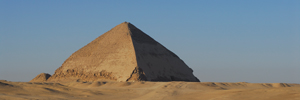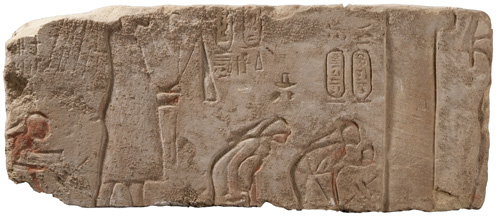 Archaeologists have discovered a large structure to the northeast of the 4,600 year old Bent Pyramid which may be the remains of an ancient harbour. It connects to one of the pyramids temples by way of a 140 meter long causeway.
Archaeologists have discovered a large structure to the northeast of the 4,600 year old Bent Pyramid which may be the remains of an ancient harbour. It connects to one of the pyramids temples by way of a 140 meter long causeway.
The discoveries were made by a team from the Cairo department of the German Archaeological Institute, and the Free University of Berlin. The team used magnetic survey and drill cores soundings to make the finds. The structure is mostly unexcavated and only a portion of the causeway has been unearthed.
The structure itself is U-shaped, 90 meters by 145 meters. It was built with mud brick and has no wall on its east side. Maybe this structure can be interpreted as (a) harbour or something like that, said Dr. Nicole Alexanian of the German Archaeological Institute, Cairo. She said that it may have been beside water, its possible that ships could enter by a canal in this area.
Harbours are known from later Egyptian pyramids and may have served as a receiving point for the body of the pharaoh. It is unlikely, however, that the newly discovered structure was used for the burial of the Bent Pyramids creator the pharaoh Snefru. It is widely believed by Egyptologists that his final resting place was the Red Pyramid, located two kilometres to the north of the Bent Pyramid.
Snefru was the first ruler of the fourth dynasty and constructed two pyramids at Dahshur (the Bent and Red Pyramids), one at Meidum, and one at Seila. These were the first true pyramids those with smooth sides. After he died, his son Khufu inherited the throne and began construction of the Great Pyramid at Giza.
A 140 meter roofed causeway
The causeway runs due east of the temple and has a vaulted roof. This appears to be the earliest known instance in which a roofed causeway was used in an Egyptian pyramid complex.
The walls – they built them to a really astonishing height, almost three meters, said Dr. Alexanian.It was like a tunnel – astonishingly its also very steep.
The interior of the causeway contained a passageway more than 2.5 meters wide. Its walls were lined with undecorated white and yellow plaster which appears to have been maintained for a long time.
Four phases of the plastering could be distinguished which attest that it was renewed several times, said the team in a recent report. From (the) state of weathering of the different plaster layers it can be inferred that the causeway was used for a substantial period of time i.e. at least 40 years.
Building the Bent Pyramid
Archaeologists are not certain why Snefru went to the trouble of building four pyramids in Egypt. The Bent pyramid, as its name suggests, has an odd angle with a slope that looks like it was changed part way through construction. It has been suggested that this was an error made by workers trying to grasp new construction techniques.
However research done by the German team suggests that the geology of the plateau played a role in the pyramids odd shape.
The ground had to be stable this was a problem with the Bent Pyramid, said Dr. Alexanian. The ground where the Bent Pyramid is built on, its not always stone, there was some taffla. Its something like muddy structures in the ground.
This affected construction. Therefore they got problems doing the ground, therefore they altered the angle of the pyramid.
Flattening the plateau
There is also evidence that the pyramid builders altered the plateau to make it flatter quarrying material from the east. The team writes ina conference abstract that the topography of the pyramid plateau can be hardly explained taking into account only fluvial processes or processes like gully erosion or soil erosion.
Therefore, for the area of the pyramid plateau a direct anthropogenic relief forming influence has to be considered. In other words humans altered theshape of the plateau.
Alexanian said that flattening the plateau would make the view from the cultivated area even more dramatic. People would have seen a flat, sharply edged, plateau, with a pyramid built on top and possibly a canal leading up to it.
A sight that would make someone living 4,600 years ago gasp in awe.








 An unpublished manuscript, written by 19th century Egypt explorer
An unpublished manuscript, written by 19th century Egypt explorer  Neferhotep was an Egyptian official who was buried in Thebes. He was an overseer of the granary, said Dr. Bednarski, probably during the reigns of
Neferhotep was an Egyptian official who was buried in Thebes. He was an overseer of the granary, said Dr. Bednarski, probably during the reigns of  In general the book is written in the style of a 19th century encyclopaedia, said Dr. Bednarski, with individual sections for each topic. However Caillaud didnt understand Egyptian hieroglyphs so he had to make his interpretations without them.
In general the book is written in the style of a 19th century encyclopaedia, said Dr. Bednarski, with individual sections for each topic. However Caillaud didnt understand Egyptian hieroglyphs so he had to make his interpretations without them. The good citizens of Milwaukee are set for a mummifying experience.
The good citizens of Milwaukee are set for a mummifying experience. A stone effigy monument, in the shape of a Blackfoot creator god named Napi, has been discovered in southern Alberta south of the Red Deer River near the hamlet of Finnegan.
A stone effigy monument, in the shape of a Blackfoot creator god named Napi, has been discovered in southern Alberta south of the Red Deer River near the hamlet of Finnegan. The Tunit made our country habitable. They built the line of boulder cairns that guide caribou to the river-crossings where they can be ambushed by hunters, and they furnished the rivers with fish-weirs. An Inuit story, from Ancient People of the Arctic by Dr. Robert McGhee
The Tunit made our country habitable. They built the line of boulder cairns that guide caribou to the river-crossings where they can be ambushed by hunters, and they furnished the rivers with fish-weirs. An Inuit story, from Ancient People of the Arctic by Dr. Robert McGhee One of the most intriguing artefacts theyve found is a5 centimetre long
One of the most intriguing artefacts theyve found is a5 centimetre long To obtain the ivory for the maskette, the people would have hunted walrus going out on the Arctic Ocean to do so. As far as we know the Dorset only had small skin boats, like kayaks, Lofthouse said. Definitely it could have been dangerous.
To obtain the ivory for the maskette, the people would have hunted walrus going out on the Arctic Ocean to do so. As far as we know the Dorset only had small skin boats, like kayaks, Lofthouse said. Definitely it could have been dangerous. Somewhere in the world bones from an ancient skeleton are discovered buried in an unmarked grave.
Somewhere in the world bones from an ancient skeleton are discovered buried in an unmarked grave. The debate over the origin of the Dead Sea Scrolls may end up coming down to a very basic element water.
The debate over the origin of the Dead Sea Scrolls may end up coming down to a very basic element water. They claim to have identified the origin of the longest of the Dead Sea Scrolls (known as The Temple Scroll) by identifying the source of the water used to make the parchment.
They claim to have identified the origin of the longest of the Dead Sea Scrolls (known as The Temple Scroll) by identifying the source of the water used to make the parchment. A Toronto newspaper is reporting that Chinese President Hu Jintao may kick-off the
A Toronto newspaper is reporting that Chinese President Hu Jintao may kick-off the